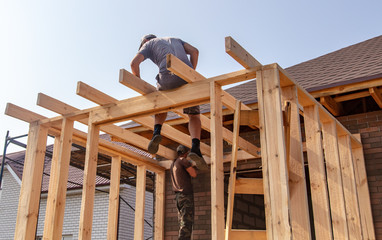Carpentry is an essential trade that combines skill, precision, and creativity to transform raw wood into functional and aesthetically pleasing structures. From furniture and cabinetry to home renovations and custom woodwork, carpentry plays a vital role in both residential and commercial projects. Understanding the tools, techniques, and best practices of carpentry allows craftsmen and homeowners alike to achieve durable, high-quality results. By mastering carpentry, individuals can create custom solutions that enhance the functionality and beauty of any space.

The Importance of Carpentry
Carpentry is more than just woodworking—it is a craft that shapes the functionality and appearance of living and working environments. Skilled carpentry ensures the structural integrity of furniture, cabinetry, and architectural elements. Well-executed carpentry projects improve the value of a property, optimize space, and provide long-lasting durability. Whether building a custom bookshelf, installing hardwood flooring, or constructing outdoor structures, carpentry combines technical skill with creative design to meet practical needs while adding aesthetic appeal.
Key Skills in Carpentry
Successful carpentry requires a combination of technical skills, creativity, and attention to detail. Some essential skills include:
- Measuring and Layout: Accurate measurements and precise markings are critical for achieving professional results.
- Cutting and Shaping: Using hand tools and power tools to cut, plane, and shape wood ensures smooth, precise components.
- Joinery Techniques: Understanding different types of joints, such as dovetail, mortise and tenon, and lap joints, enhances strength and durability.
- Finishing: Sanding, staining, painting, and sealing protect wood surfaces and enhance their visual appeal.
- Problem-Solving: Adjusting designs and resolving issues during construction requires creativity and adaptability.
By mastering these skills, carpenters can produce high-quality work that is both functional and visually appealing.
Tools and Equipment for Carpentry
Carpentry relies on a variety of tools, both hand tools and power tools, to achieve precision and efficiency. Common tools include saws, chisels, hammers, planes, levels, drills, and sanders. Power tools, such as table saws, circular saws, routers, and nail guns, accelerate the construction process while maintaining accuracy. Safety equipment, including gloves, goggles, and hearing protection, is essential for preventing accidents and ensuring a safe working environment. Proper use and maintenance of tools are critical for producing professional-quality results.
Types of Carpentry
Carpentry encompasses several specialized areas, each with unique applications and techniques:
- Rough Carpentry: Focuses on structural work, such as framing, flooring, and roofing, providing the foundation for buildings and other structures.
- Finish Carpentry: Involves detailed work, including trim, molding, cabinetry, and furniture, enhancing the appearance and functionality of interiors.
- Cabinetry and Furniture Carpentry: Specialized carpentry dedicated to building cabinets, tables, chairs, and custom furniture pieces.
- Restoration Carpentry: Involves repairing, restoring, or replicating historic woodwork to preserve the character and integrity of structures.
Understanding these carpentry types helps homeowners and professionals choose the right approach for their projects.
Benefits of Professional Carpentry
Hiring or performing professional carpentry ensures superior quality, durability, and aesthetic appeal. Skilled carpenters bring expertise in measurements, materials, and construction techniques, reducing errors and waste. Professional carpentry also adds value to properties by creating customized, long-lasting solutions that reflect individual style and needs. Whether it’s custom cabinetry, shelving, or architectural trim, professional carpentry enhances both functionality and visual appeal.
Carpentry Materials
Selecting the right materials is a crucial part of successful carpentry. Common materials include hardwoods, softwoods, plywood, MDF, and engineered wood. Hardwoods such as oak, maple, and cherry are durable and ideal for furniture and cabinetry, while softwoods like pine are easier to work with and suitable for structural components. Engineered wood products provide cost-effective alternatives with consistent quality and reduced warping. Proper material selection ensures durability, strength, and a polished finish.
Carpentry Techniques and Best Practices
High-quality carpentry relies on precise techniques and best practices. Key techniques include:
- Accurate Measuring and Marking: Ensures that components fit perfectly and align correctly.
- Proper Cutting and Jointing: Maintains structural integrity and enhances aesthetic appeal.
- Sanding and Finishing: Smooths surfaces and protects wood against moisture, wear, and aging.
- Maintenance of Tools: Sharp, well-maintained tools improve accuracy and reduce effort.
- Planning and Layout: Careful project planning prevents mistakes, saves time, and minimizes material waste.
Applying these practices consistently ensures successful carpentry projects that stand the test of time.
Carpentry Safety Tips
Safety is paramount in carpentry. Using sharp tools, operating power equipment, and handling heavy materials carries inherent risks. Key safety practices include wearing protective gear, keeping the workspace organized, using tools as intended, and following manufacturer guidelines. Additionally, proper training and awareness of potential hazards reduce the risk of accidents, ensuring a safe and productive work environment.
Sustainable Carpentry Practices
Sustainable carpentry focuses on environmentally friendly materials, waste reduction, and energy-efficient techniques. Using responsibly sourced wood, recycled materials, and low-VOC finishes minimizes environmental impact. Efficient material use, careful planning, and repurposing scrap wood contribute to sustainability while maintaining high-quality results. Eco-conscious carpentry not only benefits the environment but also appeals to clients seeking green and responsible construction solutions.
Carpentry is a versatile and valuable craft that combines skill, creativity, and precision to create functional and beautiful woodwork. From rough framing to detailed finish carpentry, understanding tools, techniques, materials, and safety measures ensures high-quality results. Professional carpentry enhances property value, provides durable solutions, and allows for custom designs tailored to individual needs. By mastering carpentry skills and applying best practices, homeowners and craftsmen alike can transform raw wood into long-lasting, aesthetically pleasing structures, furniture, and architectural elements. Investing in quality carpentry ensures durable, functional, and visually stunning results that stand the test of time.